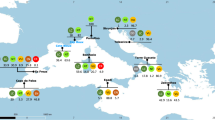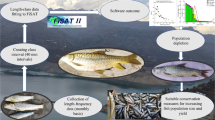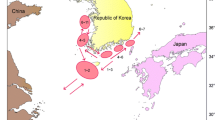Abstract
There are two major kinds of fisheries for the chub mackerel in Japan. The purse seine net fishery exploits young and adult fish during the foraging season, while the dip net fishery exploits fish before and during the spawning season. To compare the damage to the chub mackerel stock caused by purse seine net and dip net fisheries, we introduced impact factors of the two kinds of fisheries on the two kinds of fisheries and estimated number of eggs spawned in 1982. We defined the impact factor as the ratio of the average reproductive value of individuals caught by each fishery to the reproductive value at maturity. The number of individuals caught by the purse seine net fishery was 66 times larger than the number caught by the dip net fishery, while the impact factor of the former was 84% of that of the latter. Thus, the total damage caused by the purse seine net fishery was much higher than the damage caused by the dip net fishery. We can evaluate the damage caused by mortality factors on endangered species using this method.
Similar content being viewed by others
References
Doi, T. (1973) A rapid method to estimate the optimum coefficient of fishing mortality ofChrysophrys major in the East China Sea and the Yellow Sea.Bull. Jpn. Soc. Sci. Fish. 39: 1–5. [in Japanese]
Fisher, R. A. (1930)The genetical theory of natural selection. Clarendon Press, Oxford (Reprinted 1958, Dover, New York).
Kotaki, K. (1991)Report on the technological development test of long-term forecasting on fisheries and oceanographic conditions (Heisei 2 fiscal year). Japan Fisheries Information Service Center, Tokyo, Japan. pp. 81–100.
Matsuda, H., T. Wada, Y. Takeuchi and Y. Matsumiya (1991) Alternative models of species replacement of pelagic fishes.Res Popul. Ecol. 33: 41–56.
Matsuda, H., T. Kishida and T. Kidachi (1992) Optimal harvesting policy for chub mackerel in Japan under a fluctuating environment.Can. J. Fish. Aquat. Sci. 49: 1796–1800.
Mitani, I. (1993) Does resource conservation contradict development of fisheries for chub mackerel?Proc. Fish. Res. Manag. 9: 8–14. (In Japanese)
Pianka, E. R. (1978)Evolutionary ecology (2nd edition). Harper & Row, New York.
Pope, J. G. (1972) An investigation of the accuracy of virtual population using cohort analysis.Res. Bull. Int. Comm. Northwest. Atlant. Fish. 9: 65–74.
Reed, W. J. (1980) Optimum age-specific harvesting in a nonlinear population model.Biometrics 36: 579–593.
Watanabe, T. (1983) Spawning survey method. pp. 9–29.In T. Ishii (ed.)Population dynamics of fishery resources. Koseisha-Koseikaku, Tokyo. (in Japanese).
Author information
Authors and Affiliations
Rights and permissions
About this article
Cite this article
Matsuda, H., Mitani, I. & Asano, K. Impact factors of purse seine net and dip net fisheries on a chub mackerel population. Res Popul Ecol 36, 201–207 (1994). https://doi.org/10.1007/BF02514936
Received:
Accepted:
Issue Date:
DOI: https://doi.org/10.1007/BF02514936




